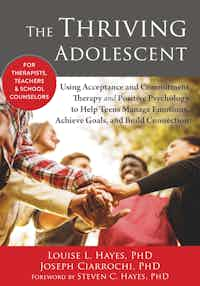In ACT, every discussion has a value behind it. Sometimes what a person cares about is explicit; other times it’s hidden. As mental health practitioners, our job is to be on the alert, always asking, “What does the client care about here?”
Value doesn’t appear only when people talk about positive experiences; it also shows up when they discuss painful experiences. For example, nobody has experienced friendship and love without also experiencing disappointment and rejection. Our task is to help people connect with their values, even in painful experiences.
Values are an individual’s choice, and, theoretically, people can choose to value anything, even antisocial things. This possibility can be discomforting to practitioners, who often wonder what to do if an individual’s values are out of sync with their own. For example, what if somebody says he values harming others? What do we do? When faced with clients whose values conflict with our own, we have only two choices: We can refuse to work with them or refuse to work on particular values, such as antisocial ones.
The good news is that value-based conflicts between practitioners and those they work with are rare, and can usually be resolved. We humans tend to be more alike in our values than different. Indeed, research has identified six patterns of valued activity that are associated with vitality and well-being (Aked et al., 2009). It’s likely that almost any young person will want to engage at least some of these patterns of activity, if not all of them:
Connecting with others. Humans are essentially social. Remove us from our social group, and we are likely to develop poor mental health, get sick, and die (Hawkley & Cacioppo, 2010; Sarason & Sarason, 1985). Take a moment now to answer this question: What is most important in your life? Does your answer involve other people?
Giving to others and having a positive influence. Giving is a pattern of activity that’s likely to be forced upon young people. Even so, research suggests that giving may be intrinsically reinforcing (Rilling et al., 2007), so if we can find ways to help young people experience giving, they’ll be likely to discover their own authentic reasons for giving. There is no need to force-feed them this value.
Being active. Physical activity is associated with greater well-being and lower rates of depression and anxiety across all age groups (Biddle & Ekkekakis, 2005). Recent research also suggests that activity may improve intellectual performance (Singh, Uijtdewilligen, Twisk, van Mechelen, & Chinapaw, 2012). In addition, physical activity can support other values, such as connecting with others and embracing the moment (Ciarrochi et al., 2014).
Embracing the moment. This broad category involves fully partaking of whatever is immediately in front of us, rather than being focused on the future or the past. This value spans many modes of experience, from exploring and traveling to playing music and enjoying food. For this reason, it’s likely to overlap with many, if not all, of the other categories of values.
Challenging ourselves and learning. It’s a myth that people are happiest when they have no work and can live a challenge-free life. In fact, evidence suggests that unemployment is one of the strongest predictors of poor well-being (McKee-Ryan, Song, Wanberg, & Kinicki, 2005). Researchers have found that when people are immersed in a challenge, they tend to experience increased subjective well-being (Csikszentmihalyi & Hunter, 2003).
Caring for ourselves. This category refers to a broad range of self-care behaviors, such as maintaining a healthy diet, getting enough sleep, and doing something relaxing after a hard day. Note that in describing these six patterns of behavior, we aren’t suggesting that practitioners dictate values to those they work with. Discoverer skills are designed to connect people to their values through actions. The six patterns we just described provide hints about where to look for values. For example, most young people will value connecting with others. However, the way they wish to connect with others, and the context in which they wish to connect, will differ from person to person.
This article was adapted from The Thriving Adolescent by Louise Hayes, PhD, and Joseph Ciarrochi, PhD.
References
Aked, J., Marks, N., Cordon, C., & Thompson, S. (2009). Five ways to wellbeing: A report presented to the Foresight Project on communicating the evidence base for improving people’s wellbeing. London: New Economics Foundation.
Biddle, S. J., & Ekkekakis, P. (2005). Physically active lifestyles and well-being. In F. A. Huppert, N. Baylis, & B. Keverne (Eds.), The science of well-being (pp. 140–168). New York: Oxford University Press.
Ciarrochi, J., Bailey, A., & Harris, R. (2014). The weight escape: How to stop dieting and start living. Boston: Shambhala.
Csikszentmihalyi, M., & Hunter, J. (2003). Happiness in everyday life: The uses of experience sampling. Journal of Happiness Studies, 4(2), 185–199.
Hawkley, L. C., & Cacioppo, J. T. (2010). Loneliness matters: A theoretical and empirical review of consequences and mechanisms. Annals of Behavioral Medicine, 40(2), 218–227.
McKee-Ryan, F., Song, Z., Wanberg, C. R., & Kinicki, A. J. (2005). Psychological and physical well-being during unemployment: A meta-analytic study. Journal of Applied Psychology, 90(1), 53–76.
Rilling, J. K., Glenn, A. L., Jairam, M. R., Pagnoni, G., Goldsmith, D. R., Elfenbein, H. A., et al. (2007). Neural correlates of social cooperation and non-cooperation as a function of psychopathy. Biological Psychiatry, 61(11), 1260–1271.
Sarason, I. G., & Sarason, B. R. (1985). Social support: Theory, research, and applications. Dordrecht, The Netherlands: Nihjoff.
Singh, A., Uijtdewilligen, L., Twisk, J. W., van Mechelen, W., & Chinapaw, M. J. (2012). Physical activity and performance at school: A systematic review of the literature including a methodological quality assessment. Archives of Pediatrics and Adolescent Medicine, 166(1), 49–55.



 Why Journaling Is Especially Helpful to Adult Children of Emotionally Immature Parents
Why Journaling Is Especially Helpful to Adult Children of Emotionally Immature Parents